History of NATO
The history of NATO started when British diplomacy set the stage to contain the Soviet Union and to stop the expansion of communism in Europe. The United Kingdom and France signed in 1947 signed the Treaty of Dunkirk, a defensive pact, which was expanded in 1948 with the Treaty of Brussels to add the three Benelux countries (Belgium, the Netherlands, and Luxembourg) and committed them to collective defence against any armed attack for fifty years. The British worked with Washington to expand the alliance into NATO in 1949, adding the United States and Canada as well as Italy, Portugal, Norway, Denmark, and Iceland.[1] West Germany and Spain joined later.
Beginnings
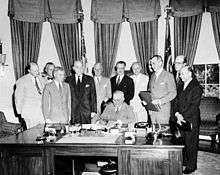
The Treaty of Brussels was a mutual defense treaty against the Soviet threat at the start of the Cold War. It was signed on 17 March 1948 by Belgium, the Netherlands, Luxembourg, France, and the United Kingdom and was the precursor to NATO. The Soviet threat became immediate with the Berlin Blockade in 1948, leading to the creation of a multinational defence organization, the Western Union Defence Organisation, in September 1948.[2] However, the parties were too weak militarily to counter the Soviet Armed Forces. In addition, the communist 1948 Czechoslovak coup d'état had overthrown a democratic government, and British Foreign Minister Ernest Bevin reiterated that the best way to prevent another Czechoslovakia was to evolve a joint Western military strategy. He got a receptive hearing in the United States, especially with the American anxiety over Italy and the Italian Communist Party.[3]
In 1948, European leaders met with US defence, military, and diplomatic officials at the Pentagon, exploring a framework for a new and unprecedented association.[4] The talks resulted in the North Atlantic Treaty, and the United States signed on 4 April 1949. It included the five Treaty of Brussels states, as well as the United States, Canada, Portugal, Italy, Norway, Denmark and Iceland.[5] The first NATO Secretary General, Lord Ismay, stated in 1949 that the organization's goal was "to keep the Russians out, the Americans in, and the Germans down".[6] Popular support for the Treaty was not unanimous, and some Icelanders participated in a pro-neutrality, anti-membership riot in March 1949. The creation of NATO can be seen as the primary institutional consequence of a school of thought called Atlanticism, which stressed the importance of trans-Atlantic co-operation.[7]

The members agreed that an armed attack against any of them in Europe or North America would be considered an attack against them all. Consequently, they agreed that if an armed attack occurred, each of them, in exercise of the right of individual or collective self-defence, would assist the member being attacked and take such action as it deemed necessary, including the use of armed force, to restore and maintain the security of the North Atlantic area. The treaty does not require members to respond with military action against an aggressor. Although obliged to respond, they maintain the freedom to choose the method by which they do so. That differs from Article IV of the Treaty of Brussels, which clearly states that the response is military in nature. NATO members are nonetheless assumed to aid the attacked member militarily. The treaty was later clarified to include both the member's territory and their "vessels, forces or aircraft" above the Tropic of Cancer, including some overseas departments of France.[8]
The creation of NATO brought about some standardization of allied military terminology, procedures, and technology, which, in many cases, meant European countries adopting US practices. Roughly 1300 Standardization Agreements (STANAG) codified many of the common practices that NATO has achieved. The 7.62×51mm NATO rifle cartridge was thus introduced in the 1950s as a standard firearm cartridge among many NATO countries.[9] Fabrique Nationale de Herstal's FAL, which used the 7.62mm NATO cartridge, was adopted by 75 countries, including many outside NATO.[10] Also, aircraft marshalling signals were standardized so that any NATO aircraft could land at any NATO base. Other standards such as the NATO phonetic alphabet have made their way beyond NATO into civilian use.[11]
Cold War
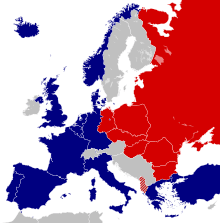
The outbreak of the Korean War in June 1950 was crucial for NATO, as it raised the apparent threat of all communist countries working together and forced the alliance to develop concrete military plans.[12] Supreme Headquarters Allied Powers Europe (SHAPE) was formed to direct forces in Europe, and began work under Supreme Allied Commander Dwight Eisenhower in January 1951.[13] In September 1950, the NATO Military Committee called for an ambitious buildup of conventional forces to meet the Soviets and reaffirmed that position at the February 1952 meeting of the North Atlantic Council in Lisbon. The conference, seeking to provide the forces necessary for NATO's Long-Term Defence Plan, called for an expansion to 96 divisions. However, that requirement was dropped the following year to roughly 35 divisions, with heavier use to be made of nuclear weapons. At th a time, NATO could call on about 15 ready divisions in Central Europe and another 10 in Italy and Scandinavia.[14][15] Also at Lisbon, the post of Secretary General of NATO as the organization's chief civilian was created, and Lord Ismay was eventually appointed to the post.[16]
In September 1952, the first major NATO maritime exercises began. Exercise Mainbrace brought together 200 ships and over 50,000 personnel to practice the defence of Denmark and Norway.[17] Other major exercises that followed included Exercise Grand Slam and Exercise Longstep, naval and amphibious exercises in the Mediterranean Sea, Italic Weld, a combined air-naval-ground exercise in northern Italy, Grand Repulse, involving the British Army on the Rhine (BAOR), the Netherlands Corps and Allied Air Forces Central Europe (AAFCE), Monte Carlo, a simulated atomic air-ground exercise involving the Central Army Group, and Weldfast, a combined amphibious landing exercise in the Mediterranean Sea involving American, British, Greek, Italian, and Turkish naval forces.[18]
Greece and Turkey also joined the alliance in 1952, which forced a series of controversial negotiations, mainly between United States and Britain, over how to bring both countries into the military command structure.[13] While that overt military preparation was going on, covert stay-behind arrangements initially made by the Western European Union to continue resistance after a successful Soviet invasion, including Operation Gladio, were transferred to NATO control. Ultimately, unofficial bonds began to grow between NATO's armed forces, such as the NATO Tiger Association and competitions such as the Canadian Army Trophy for tank gunnery.[19][20]

In 1954, the Soviet Union suggested that it should join NATO to preserve peace in Europe.[21] The NATO countries, fearing that the Soviet Union's motive was to weaken the alliance, ultimately rejected that proposal. On 17 December 1954, the North Atlantic Council approved MC 48, a key document in the evolution of NATO nuclear thought. MC 48 emphasized that NATO had to use atomic weapons from the outset of a war with the Soviet Union, whether or not the Soviets chose to use them first. That gave SACEUR the same prerogatives for automatic use of nuclear weapons that existed for the commander-in-chief of the US Strategic Air Command.
The incorporation of West Germany into the organization on 9 May 1955 was described as "a decisive turning point in the history of our continent" by Halvard Lange, then the Norwegian Foreign Affairs Minister.[22] A major reason was that German manpower was necessary to have enough conventional forces to resist a Soviet invasion.[23] One of the immediate results of West German entry was the creation of the Warsaw Pact, which was signed on 14 May 1955 by the Soviet Union, Hungary, Czechoslovakia, Poland, Bulgaria, Romania, Albania, and East Germany, thereby delineating the two opposing sides of the Cold War.
Three major exercises were held concurrently in the northern autumn of 1957. Operation Counter Punch, Operation Strikeback, and Operation Deep Water were the most ambitious military undertaking for the alliance so far, involving more than 250,000 men, 300 ships, and 1,500 aircraft operating from Norway to Turkey.[24]
French withdrawal
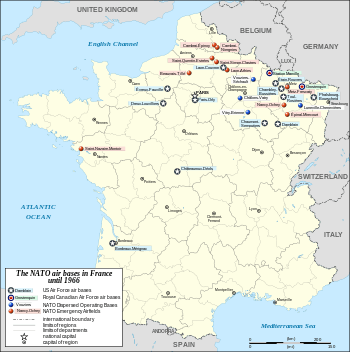
NATO's unity was breached early in its history with a crisis occurring during Charles de Gaulle's presidency of France.[25] De Gaulle protested the strong role of the United States in NATO and what he perceived as a special relationship between it and the United Kingdom. In a memorandum sent to US President Dwight Eisenhower and British Prime Minister Harold Macmillan on 17 September 1958, he argued for the creation of a tripartite directorate, which would put France on an equal footing with the US and the UK.[26]
Considering the response to be unsatisfactory, de Gaulle began constructing an independent defence force for his country. He wanted to give France, in the event of an East German incursion into West Germany, the option of coming to a separate peace with the Eastern bloc, instead of being drawn into a larger war between NATO and the Warsaw Pact.[27] In February 1959, France withdrew its Mediterranean Fleet from NATO command,[28] and it later banned the stationing of foreign nuclear weapons on French soil. That caused the United States to transfer 300 military aircraft out of France and to return control of the air force bases that it had operated in France since 1950 to the French by 1967.
Though France showed solidarity with the rest of NATO during the Cuban Missile Crisis in 1962, de Gaulle continued his pursuit of an independent defence by removing France's Atlantic and Channel fleets from NATO command.[29] In 1966, all French armed forces were removed from NATO's integrated military command, and all non-French NATO troops were asked to leave France. US Secretary of State Dean Rusk was later quoted as asking de Gaulle whether his order included "the bodies of American soldiers in France's cemeteries"[30]. The withdrawal forced the relocation of SHAPE from Rocquencourt, near Paris, to Casteau, north of Mons, Belgium, by 16 October 1967.[31] France remained a member of the alliance and committed to the defence of Europe from possible Warsaw Pact attack with its own forces stationed in West Germany throughout the Cold War. A series of secret accords between US and French officials, the Lemnitzer–Ailleret Agreements, detailed how French forces would dovetail back into NATO's command structure if East-West hostilities broke out.[32]
When de Gaulle announced his decision to withdraw from the integrated NATO command, US President Lyndon Johnson suggested that when de Gaulle "comes rushing down like a locomotive on the track, why the Germans and ourselves, we just stand aside and let him go on by, then we are back together again."[33]
That vision came true when France announced its return to full participation at the 2009 Strasbourg–Kehl summit.[34]
Détente and escalation
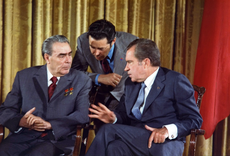
During most of the Cold War, NATO's watch against the Soviet Union and Warsaw Pact did not actually lead to direct military action. On 1 July 1968, the Treaty on the Non-Proliferation of Nuclear Weapons opened for signature. NATO argued that its nuclear sharing arrangements did not breach the treaty since US forces controlled the weapons until a decision was made to go to war, when the treaty would no longer be controlling. Few states then knew of the NATO nuclear sharing arrangements, which were not challenged. In May 1978, NATO countries officially defined two complementary aims of the Alliance: to maintain security and pursue détente. That was supposed to mean matching defences at the level rendered necessary by the Warsaw Pact's offensive capabilities without spurring a further arms race.[35]
On 12 December 1979, in light of a build-up of Warsaw Pact nuclear capabilities in Europe, ministers approved the deployment of US GLCM cruise missiles and Pershing II theatre nuclear weapons in Europe.[36] The new warheads were also meant to strengthen the West's negotiating position regarding nuclear disarmament. That policy was called the Dual Track policy.[37] Similarly, in 1983 and 1984, responding to the stationing of Warsaw Pact SS-20 medium-range missiles in Europe, NATO deployed modern Pershing II missiles tasked to hit military targets such as tank formations in the event of war.[38] That action led to peace movement protests throughout Western Europe, and support for their deployment wavered, as many doubted whether the push for deployment could be sustained.
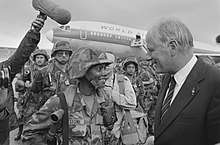
The membership of the organization was then largely static. In 1974, as a consequence of the Turkish invasion of Cyprus, Greece withdrew its forces from NATO's military command structure but, with Turkish co-operation, was readmitted in 1980.[39] The Falklands War between the United Kingdom and Argentina did not result in NATO involvement because Article 6 of the North Atlantic Treaty specifies that collective self-defence is applicable only to attacks on member state territories north of the Tropic of Cancer.[40] On 30 May 1982, NATO gained a new member when the newly-democratic Spain joined the alliance, as was confirmed by referendum in 1986. At the peak of the Cold War, 16 member nations maintained an approximate strength of 5,252,800 active military, including as many as 435,000 forward deployed US forces, under a command structure that reached a peak of 78 headquarters, organized into four echelons.[41]
After Cold War
The Revolutions of 1989 and the dissolution of the Warsaw Pact in 1991 removed the de facto main adversary of NATO and caused a strategic re-evaluation of NATO's purpose, nature, tasks, and focus on the continent of Europe. The shift started, with the 1990 signing in Paris of the Treaty on Conventional Armed Forces in Europe between NATO and the Soviet Union, which mandated specific military reductions across the continent, which continued after the dissolution of the Soviet Union in December 1991.[42] European countries then accounted for 34 percent of NATO's military spending; by 2012, that had fallen to 21 percent.[43] NATO also began a gradual expansion to include newly-autonomous countries od Central and Eastern Europe and extended its activities into political and humanitarian situations that had not been thought of as NATO concerns.

An expansion of NATO came with German reunification on 3 October 1990, when the former East Germany became part of the Federal Republic of Germany and of the alliance. That had been agreed in the Two Plus Four Treaty earlier that year. To secure Soviet approval of a united Germany remaining in NATO, it was agreed that foreign troops and nuclear weapons would not be stationed in the east. There was no formal commitment in the agreement not to expand NATO to the east, but there are diverging views on whether negotiators gave informal commitments regarding further NATO expansion.[44][45][46] Jack Matlock, the American ambassador to the Soviet Union during its final years, said that the West gave a "clear commitment" not to expand, and declassified documents indicate that Soviet negotiators were given the impression that NATO membership was off the table for countries such as Czechoslovakia, Hungary, or Poland.[47] Hans-Dietrich Genscher, then the West German foreign minister, said in a conversation with Eduard Shevardnadze, "For us, however, one thing is certain: NATO will not expand to the east."[47] In 1996, Gorbachev wrote in his Memoirs that "during the negotiations on the unification of Germany they gave assurances that NATO would not extend its zone of operation to the east,"[48] and hr repeated that view in an interview in 2008.[49] However, in 2014 Gorbachev stated the opposite: "The topic of 'NATO expansion' was not discussed at all [in 1990], and it wasn't brought up in those years. I say this with full responsibility. Western leaders didn't bring it up, either."[44][50] According to Robert Zoellick, a US State Department official involved in the Two Plus Four negotiating process, that appears to be a misperception, and no formal commitment regarding enlargement was made.[51] Harvard University historian Mark Kramer also rejects that an informal agreement existed.[44][52]
As part of restructuring, NATO's military structure was cut back and reorganized, with new forces such as the Headquarters Allied Command Europe Rapid Reaction Corps established. The changes brought about by the collapse of the Soviet Union on the military balance in Europe were recognized in the Adapted Conventional Armed Forces in Europe Treaty, which was signed in 1999. The policies of French President Nicolas Sarkozy resulted in a major reform of France's military position, culminating with the return to full membership on 4 April 2009, which also included France rejoining the NATO Military Command Structure but maintaining an independent nuclear deterrent.[32][53]
Enlargement and reform
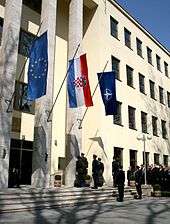
Between 1994 and 1997, wider forums for regional cooperation between NATO and its neighbors were set up, like the Partnership for Peace, the Mediterranean Dialogue initiative, and the Euro-Atlantic Partnership Council. In 1998, the NATO–Russia Permanent Joint Council was established. On 8 July 1997, three former communist countries (Hungary, the Czech Republic, and Poland) were invited to join NATO, which was accepted by all three, with Hungarian acceptance being endorsed in a referendum in which 85.3% of voters supported joining NATO.
Czech President Vaclav Havel welcomed the expansion: "Never have we been part of such a broad, solid and binding security alliance, which at the same time respects in its essence the sovereignty and will of our nation." Polish Foreign Minister Bronislaw Geremek also welcomed the expansion: "Poland forever returns where she has always belonged: the free world." Hungarian Foreign Minister Janos Martonyi stated that the expansion showed that Hungary was returning "to her natural habitat." The expansion was also welcomed by US Secretary of State Madeleine Albright, who stated that the expansion would do "for Europe's east what NATO has already helped to do for Europe's west: steadily and systematically, we will continue erasing – without replacing – the line drawn in Europe by Stalin's bloody boot."[54]
Expansion was criticised in the US by some policy experts as a "a policy error of historic proportions."[55] According to George F. Kennan, an American diplomat and an advocate of the containment policy, the decision "may be expected to have an adverse effect on the development of Russian democracy; to restore the atmosphere of the cold war to East-West relations, to impel Russian foreign policy in directions decidedly not to our liking."[56]
Membership went on expanding with the accession of seven more Central and Eastern European countries to NATO: Estonia, Latvia, Lithuania, Slovenia, Slovakia, Bulgaria, and Romania. They were first invited to start talks of membership during the 2002 Prague summit and joined NATO on 29 March 2004, shortly before the 2004 Istanbul summit. Slovenian membership was endorsed in a referendum in which 66.02% of voters supported joining.
New NATO structures were also formed while old ones were abolished. In 1997, NATO reached agreement on a significant downsizing of its command structure from 65 headquarters to 20.[57] The NATO Response Force (NRF) was launched at the 2002 Prague summit on 21 November, the first summit in a former Comecon country. On 19 June 2003, a further restructuring of the NATO military commands began as the Headquarters of the Supreme Allied Commander, Atlantic were abolished and a new command, Allied Command Transformation (ACT), was established in Norfolk, Virginia, United States, and the Supreme Headquarters Allied Powers Europe (SHAPE) became the Headquarters of Allied Command Operations (ACO). ACT is responsible for driving transformation (future capabilities) in NATO while ACO is responsible for current operations.[58] In March 2004, NATO's Baltic Air Policing began, which supported the sovereignty of Latvia, Lithuania, and Estonia by providing jet fighters to react to any unwanted aerial intrusions. Eight multinational jet fighters are based in Lithuania, the number of which was increased from four in 2014.[59] Also at the 2004 Istanbul summit, NATO launched the Istanbul Cooperation Initiative with four Persian Gulf nations.[60]

The 2006 Riga summit was held in Riga, Latvia, and highlighted the issue of energy security. It was the first NATO summit to be held in a country that had been part of the Soviet Union. At the April 2008 summit in Bucharest, Romania, NATO agreed to the accession of Croatia and Albania, both of which joined NATO in April 2009. Ukraine and Georgia were also told that they could eventually become members.[61] The issue of Georgian and Ukrainian membership in NATO prompted harsh criticism from Russia, as did NATO plans for a missile defence system. Studies for the system had begun in 2002, with negotiations centered on anti-ballistic missiles being stationed in Poland and the Czech Republic. Though NATO leaders gave assurances that the system was not targeting Russia, Russian Presidents Vladimir Putin and Dmitry Medvedev criticized the system as a threat.[62]
In 2009, US President Barack Obama proposed using the ship-based Aegis Combat System, but the plan still includes stations being built in Turkey, Spain, Portugal, Romania, and Poland.[63] NATO will also maintain the "status quo" in its nuclear deterrent in Europe by upgrading the targeting capabilities of the "tactical" B61 nuclear bombs stationed there and deploying them on the stealthier Lockheed Martin F-35 Lightning II.[64][65] After the 2014 annexation of Crimea by Russia, NATO committed to forming a new "spearhead" force of 5000 troops at bases in Estonia, Lithuania, Latvia, Poland, Romania, and Bulgaria.[66][67]
.jpg)
The 2004 Russian annexation of Crimea led to strong condemnation by NATO nations, and Poland invoked Article 4 in meetings.[68] Then, at the 2014 Wales summit, the leaders of NATO's member states formally committed for the first time spend the equivalent of at least 2% of their gross domestic product on defence by 2024, which was previously only an informal guideline.[69] In 2015, five of its 28 members met that goal.[70][71][72] At the beginning of 2018, eight members either were meeting the target or were close to it; six others had laid out plans to reach the target by 2024 as promised; and Norway and Denmark had unveiled plans to substantially boost defense spending, including Norway's planned purchase 52 new F-35 fighter jets.[73]
On 15 June 2016, NATO officially recognized cyberwarfare as an operational domain of war, just like land, sea, and aerial warfare. That means that any cyber attack on NATO members can trigger Article 5 of the North Atlantic Treaty.[74] Montenegro became the 29th member of NATO on 5 June 2017, amid strong objections from Russia.[75][76]
On 1 August 2018, the US Department of Treasury sanctioned two senior Turkish government ministers who were involved in the detention of American pastor Andrew Brunson.[77] Turkish President Recep Tayyip Erdoğan said that the US behavior would force Turkey to look for new friends and allies.[78] The US–Turkey dispute appears to be one of the most serious diplomatic crisis between the NATO allies in years.[79][80]
On 4 December 2019, NATO officially recognized space warfare as an operational domain of war, just like land, sea, aerial, and cyber warfare. That means that an attack on any of the domain can trigger Article 5 of the North Atlantic Treaty.[81] On 27 March 2020, North Macedonia became the 30th and newest member after a dispute about its name had been resolved with Greece.
Structural changes
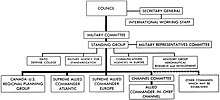
The Defence Planning Committee was a former senior decision-making body on matters relating to the integrated military structure of the Alliance. It was dissolved after a major committee review in June 2010, with its responsibilities absorbed by the North Atlantic Council.
Civilian structure
In NATO: The First Five Years, Lord Ismay described the civilian structure as follows:[82]
The ..Office of the Secretary General [is] directed by an Executive Secretary, Captain R.D. Coleridge (UK), who is also Secretary to the Council. He is responsible for supervising the general processing of the work of the Council and their committees, including provision of all secretarial assistance, as well as supervision of the administrative services of the Staff/Secretariat itself. Thus the Secretariat provides secretaries to all the Council's principal committees and working groups - apart from those of a strictly technical nature - and ensures co-ordination between them.... On the Staff side there are three main divisions corresponding to the three principal aspects of NATO's work, each under an Assistant Secretary General. Ambassador Sergio Fenoaltea (Italy) heads the Political Affairs Division, M. Rene Sergent (France) the Economics and Finance Division, and Mr. Lowell P. Weicker (USA) the Production and Logistics Division. The Divisions' tasks are to prepare, in close touch with delegations, proposed action in their respective fields for consideration by the appropriate committee or by the Council. In addition to the main divisions there are three other offices working directly to the Secretary General. These are the Office of Statistics (Mr. Loring Wood of the USA), the Financial Comptroller's Office (M. A. J. Bastin of Belgium), and the Division of Information (Mr. Geoffrey Parsons, Jr. of the USA). The Information Division, besides providing material about NATO for the use of member governments, (it does not engage in independent operations), is also the press and public relations branch of the civilian authority.
Military structure
The Strategic Commanders were the former Major NATO Commanders, who sat atop a command hierarchy consisting of Major Subordinate Commanders (MSCs), Principal Subordinate Commanders (PSCs) and Sub-PSCs.[83] The Military Committee had an executive body, the Standing Group, made up of representatives from France, the United States, and the United Kingdom. The Standing Group was abolished during the major reform of 1967 that resulted from France's departure from the NATO Military Command Structure.[84]
- Coats of arms of historical NATO commands
.svg.png) Allied Command Europe: Supreme Headquarters
Allied Command Europe: Supreme Headquarters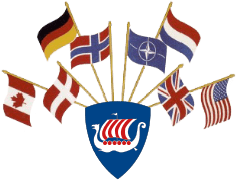 Allied Command Europe: Allied Forces Northern Europe
Allied Command Europe: Allied Forces Northern Europe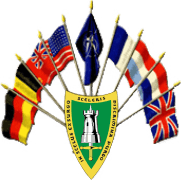 Allied Command Europe: Allied Forces Central Europe
Allied Command Europe: Allied Forces Central Europe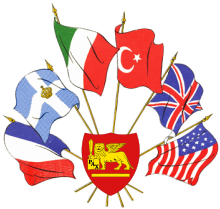 Allied Command Europe: Allied Forces Southern Europe
Allied Command Europe: Allied Forces Southern Europe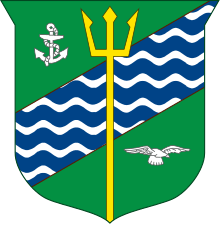
 Allied Command Atlantic
Allied Command Atlantic
Beginnings
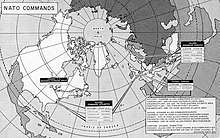
A key step in establishing the NATO Command Structure was the North Atlantic Council's selection of General Dwight Eisenhower as the first Supreme Allied Commander Europe (SACEUR) in December 1950.[84] After Eisenhower arrived in Paris in January 1951, he and the other members of the multinational Supreme Headquarters Allied Powers Europe (SHAPE) Planning Group immediately began to devise a structure for the new Allied Command Europe. NATO official documents state, "The corner stone of the NATO Military Command Structure was laid... when the North Atlantic Council approved D.C. 24/3 on 18 December 1951."[85] They quickly decided to divide Allied Command Europe into three regions: Allied Forces Northern Europe, containing Scandinavia, the North Sea, and the Baltic; Allied Forces Central Europe, and Allied Forces Southern Europe (AFSOUTH), covering Italy and the Mediterranean. SHAPE was established at Rocquencourt, west of Paris.
The British post of Commander in Chief Mediterranean Fleet was given a dual-hatted role as NATO Commander in Chief of Allied Forces Mediterranean in charge of all forces assigned to NATO in the Mediterranean Area. The British made strong representations in discussions regarding the Mediterranean NATO command structure since they wished to retain their direction of NATO naval command in the Mediterranean to protect their sea lines of communication running through the Mediterranean to the Middle East and Far East.[86]
In 1952, after Greece and Turkey joined NATO [87] Allied Land Forces South-Eastern Europe (LANDSOUTHEAST) was created in Izmir, Turkey, under a US Army General because of the geographic distance of both countries from the LANDSOUTH headquarters as well as political disagreements over which nation should be the overall commander for its ground forces.
With the establishment of Allied Command Atlantic (ACLANT) on 30 January 1952, the Supreme Allied Commander Atlantic joined the previously created Supreme Allied Commander Europe as one of the alliance's two Major NATO Commanders.[88] A third was added when Allied Command Channel was established on 21 February 1952 to control the English Channel and North Sea area and deny them to the enemy and to protect the sea lanes of communication.[89][90] The establishment of this post and the agreement that it was to be filled by the British Commander-in-Chief, Portsmouth, was part of the compromise that allowed an American officer to take up the SACLANT post. Previously Commander-in-Chief Portsmouth had controlled multinational naval operations in the area under WUDO auspices. In due course, the CINCHAN role was assumed by the British Commander-in-Chief Fleet.
In 1966, when French President Charles de Gaulle withdrew French forces from the military command structure, NATO's headquarters was forced to move to Belgium. SHAPE was moved to Casteau, north of the Belgian city of Mons. Headquarters Allied Forces Central Europe was moved from the Chateau de Fontainebleau, near Paris to Brunssum, in the Netherlands.
Structure in 1989
- NATO Military Committee, led by the Chairman of the NATO Military Committee, in Brussels, Belgium
- Allied Command Europe (ACE), led by Supreme Allied Commander Europe (SACEUR), in Mons, Belgium
- ACE Mobile Force, in Seckenheim, Germany
- United Kingdom Air Forces, in High Wycombe, United Kingdom
- NATO Airborne Early Warning Force, in Maisieres, Belgium
- Allied Forces Northern Europe (AFNORTH), in Kolsås, Norway
- Allied Forces North Norway (NON), in Bodø, Norway
- Allied Forces South Norway (SONOR), in Stavanger, Norway
- Allied Forces Baltic Approaches (BALTAP), in Karup, Denmark
- Allied Forces Central Europe (AFCENT), in Brunssum, Netherlands
- Northern Army Group (NORTHAG), in Rheindahlen, West Germany
- Central Army Group (CENTAG), in Heidelberg, West Germany
- Allied Air Forces Central Europe (AAFCE), in Ramstein, West Germany
- Second Allied Tactical Air Force (2 ATAF), in Rheindahlen, West Germany
- Fourth Allied Tactical Air Force (4 ATAF), in Ramstein, West Germany
- Allied Forces Southern Europe (AFSOUTH), in Naples, Italy
- Allied Land Forces Southern Europe (LANDSOUTH), in Verona, Italy
- Allied Land Forces South-Eastern Europe (LANDSOUTHEAST), in İzmir, Turkey
- Allied Air Forces Southern Europe (AIRSOUTH), in Naples, Italy
- Fifth Allied Tactical Air Force (5 ATAF), in Vicenza, Italy
- Sixth Allied Tactical Air Force (6 ATAF), in İzmir, Turkey
- Allied Naval Forces Southern Europe (NAVSOUTH), in Naples, Italy
- Naval Striking and Support Forces Southern Europe (STRIKFORSOUTH), afloat, centered around US Sixth Fleet
- Allied Command Atlantic (ACLANT), led by Supreme Allied Commander Atlantic (SACLANT), in Norfolk, United States[91]
- Eastern Atlantic Area (EASTLANT), in Northwood, United Kingdom
- Northern Sub-Area (NORLANT), in Rosyth, United Kingdom
- Central Sub-Area (CENTLANT), in Plymouth, United Kingdom
- Submarine Force Eastern Atlantic (SUBEASTLANT), in Gosport, United Kingdom
- Maritime Air Eastern Atlantic (MAIREASTLANT), in Northwood, United Kingdom
- Maritime Air Northern Sub-Area (MAIRNORLANT), in Rosyth, United Kingdom
- Maritime Air Central Sub-Area (MAIRCENTLANT), in Plymouth, United Kingdom
- Island Command Iceland (ISCOMICELAND), in Keflavík, Iceland
- Island Command Faroes (ISCOMFAROES), in Tórshavn, Faroe Islands
- Western Atlantic Area (WESTLANT), in Norfolk, United States
- Ocean Sub-Area (OCEANLANT), in Norfolk, United States
- Canadian Atlantic Sub-Area (CANLANT), in Halifax, Canada
- Island Command Bermuda (ISCOMBERMUDA), in Hamilton, Bermuda
- Island Command Azores (ISCOMAZORES), in Ponta Delgada, Azores
- Island Command Greenland (ISCOMGREENLAND), in Grønnedal, Greenland
- Submarine Force Western Atlantic (SUBWESTLANT), in Norfolk, United States
- Iberian Atlantic Area (IBERLANT), in Oeiras, Portugal
- Striking Fleet Atlantic (STRIKFLTLANT), in Norfolk, United States
- Carrier Striking Force (CARSTRIKFOR), in Norfolk, United States
- Carrier Striking Group One (CARSTRIKGRUONE), in Norfolk, United States
- Carrier Striking Group Two (CARSTRIKGRUTWO), in Plymouth, United Kingdom
- Carrier Striking Force (CARSTRIKFOR), in Norfolk, United States
- Submarines Allied Command Atlantic (SUBACLANT), in Norfolk, United States
- Eastern Atlantic Area (EASTLANT), in Northwood, United Kingdom
- Allied Command Channel (ACCHAN), in Northwood, United Kingdom
- Nore Sub-Area Channel Command (NORECHAN), in Rosyth, United Kingdom
- Plymouth Sub-Area Channel Command (PLYMCHAN), in Plymouth, United Kingdom
- Benelux Sub-Area Channel Command (BENECHAN), in Den Helder, Netherlands
- Allied Maritime Air Force Channel (MAIRCHAN), in Northwood, United Kingdom
- Maritime Air Nore Sub-Area Channel Command (MAIRNORECHAN), in Rosyth, United Kingdom
- Maritime Air Plymouth Sub-Area Channel Command (MAIRPLYMCHAN), in Plymouth, United Kingdom
- Standing Naval Force Channel (STANAVFORCHAN), afloat
- Allied Command Europe (ACE), led by Supreme Allied Commander Europe (SACEUR), in Mons, Belgium
After Cold War
By June 1991, it was clear that Allied Forces Central Europe, a Major Subordinate Command, could be reduced, with the Soviet threat disappearing. Six multinational corps were to replace the previous eight.[92] Announcements in June 1991 presaged main defensive forces consisting of six multinational corps. Two were to be under German command, one with a US division, one under Belgian command with a pending offer of a U.S. brigade, one under U.S. command with a German division, one under joint German-Danish command (LANDJUT), and one under Dutch command. The new German IV Corps was to be stationed in eastern German and was not to be associated with the NATO structure.
On July 1, 1994, the Alliance disestablished Allied Command Channel but retained many of its subordinate structures after the reshuffling. Most of the headquarters were absorbed within ACE, particularly within the new Allied Forces Northwestern Europe.[93]

From 1994 to 1999, ACE had three Major Subordinate Commands, AFNORTHWEST, AFCENT, and AFSOUTH. In 1995 NATO began a Long Term Study to examine post-Cold War strategy and structure. Recommendations from the study for a new, streamlined structure emerged in 1996.[94] The European and Atlantic commands were to be retained, but the number of major commands in Europe was to be cut from three to two, Regional Command North Europe and Regional Command South Europe. Activation of the new RC SOUTH occurred in September 1999, and in March 2000 Headquarters AFNORTHWEST closed and the new RC NORTH was activated.[95] The headquarters of the two Regional Commands were known as Regional Headquarters South (RHQ South) and RHQ NORTH respectively. Each was to supervise air, naval, and land commands for their region as well as a number of Joint Subregional Commands (JSRCs). Among the new JSRCs was Joint Headquarters Southwest, which was activated in Madrid in September 1999.
Organizations and agencies
Prior to the reorganization, the NATO website listed 43 different agencies and organizations and five project committees/offices as of 15 May 2008.[96] including:
- Logistics committees, organisations and agencies, including:
- NATO Maintenance and Supply Agency
- Central Europe Pipeline System
- NATO Pipeline System
- Production Logistics organisations, agencies and offices including the NATO Eurofighter and Tornado Management Agency
- Standardisation organisation, committee, office and agency including the NATO Standardization Agency which also plays an important role in the global arena of standards determination.
- Civil Emergency Planning committees and centre
- Air Traffic Management and Air Defence committees, working groups organisation and centre including the:
- NATO ACCS Management Agency (NACMA), based in Brussels, manages around a hundred persons in charge of the Air Control and Command System (ACCS) due for 2009.
- NATO Programming Centre
- The NATO Airborne Early Warning and Control Programme Management Organisation (NAPMO)
- NATO Consultation, Command and Control Organisation (NC3O)
- NATO Consultation, Command and Control Agency (NC3A),[97] reporting to the NATO Consultation, Command and Control Organization (NC3O). This agency was formed when the SHAPE Technical Centre (STC) in The Hague (Netherlands) merged in 1996 with the NATO Communications and Information Systems Operating and Support Agency (NACISA) based in Brussels (Belgium). The agency comprises around 650 staff, of which around 400 are located in The Hague and 250 in Brussels.
- NATO Communications and Information Systems Services Agency (NCSA), based in Mons (BEL), was established in August 2004 from the former NATO Communications and Information Systems Operating and Support Agency (NACISA).[98]
- NATO Headquarters C3 Staff (NHQC3S), which supports the North Atlantic Council, Military Committee, International Staff, and the International Military Staff.
- NATO Electronic Warfare Advisory Committee (NEWAC)
- Military Committee Meteorological Group (MCMG)
- The Military Oceanography Group (MILOC)
- NATO Research and Technology Organisation (RTO),[99]
- Education and Training college, schools and group
- Project Steering Committees and Project Offices, including:
- Alliance Ground Surveillance Capability Provisional Project Office (AGS/PPO)
- Battlefield Information Collection and Exploitation System (BICES)
- NATO Continuous Acquisition and Life Cycle Support Office (CALS)
- NATO FORACS Office
- Munitions Safety Information Analysis Center (MSIAC)
- Committee of Chiefs of Military Medical Services in NATO (COMEDS)
See also
References
- Cees Wiebes and Bert Zeeman, "The Pentagon Negotiations March 1948: The Launching of the North Atlantic Treaty." International Affairs 59.3 (1983): 351-363.
- Isby & Kamps Jr. 1985, p. 13.
- Pedaliu 2003, p. 97.
- Cees Wiebes and Bert Zeeman, "The Pentagon Negotiations March 1948: The Launching of the North Atlantic Treaty." International Affairs 59.3 (1983): 351-363.
- "A short history of NATO". NATO. Retrieved 26 March 2017.
- Reynolds 1994, p. 13.
- Straus, Ira (June 2005). "Atlanticism as the Core 20th Century US Strategy for Internationalism" (PDF). Streit Council. Annual Meeting of the Society of Historians of American Foreign Relations. Retrieved 10 July 2013.
- "Protocol to the North Atlantic Treaty on the Accession of Greece and Turkey". NATO. 4 April 1949. Retrieved 17 January 2012.
- "Proof and Inspection Committee NATO 7.62 MM Ammunition". NATO.
- Willbanks 2004, pp. 129–130.
- "NATO Declassified – NATO Alphabet". NATO.
- Isby & Kamps Jr. 1985, pp. 13–14.
- Ismay, Hastings (4 September 2001). "NATO the first five years 1949–1954". NATO. Archived from the original on 15 March 2017. Retrieved 10 April 2012.
- Osgood 1962, p. 76.
- Park 1986, p. 28.
- "NATO: The Man with the Oilcan". Time. 24 March 1952. Retrieved 17 January 2012.
- Baldwin, Hanson (28 September 1952). "Navies Meet the Test in Operation Mainbrace". New York Times: E7. Retrieved 10 April 2012.
- Ismay, Hastings (17 September 2001). "NATO the First 5 Years". NATO the first five years 1949–1954. NATO. Archived from the original on 15 March 2017. Retrieved 26 March 2017.
- "Organisation". NATO Tiger Association. 2013. Archived from the original on 3 November 2013. Retrieved 4 September 2013.
- "Historical Overview". Canadian Army Trophy. 5 October 2012. Retrieved 4 September 2013.
- "Fast facts about NATO". CBC News. 6 April 2009. Retrieved 16 July 2011.
- "West Germany accepted into Nato". BBC News. 9 May 2011. Retrieved 17 January 2012.
- Isby & Kamps Jr. 1985, p. 15.
- "Emergency Call". Time. 30 September 1957. Retrieved 27 September 2008.
- Garret Martin, "The 1967 withdrawal from NATO – a cornerstone of de Gaulle's grand strategy?" Journal of Transatlantic Studies (2011) 9#3 pp. 232–243. doi:10.1080/14794012.2011.593819
- Wenger, Nuenlist & Locher 2007, pp. 67–69.
- Dowd, Alan (22 September 2009). "Not Enough NATO In Afghanistan". CBS News. Retrieved 4 September 2013.
- National Defense University 1997, p. 50.
- van der Eyden 2003, pp. 104–106.
- Schoenbaum 1988, p. 421.
- Le Blévennec, François (25 October 2011). "The Big Move". NATO Review. Retrieved 19 December 2011.
- Cody, Edward (12 March 2009). "After 43 Years, France to Rejoin NATO as Full Member". The Washington Post. Retrieved 19 December 2011.
- Cited in William I. Hitchcock, "The Ghosts of Crises Past: The Troubled Alliance in Historical Perspective," The End of the West? Crisis and Change in the Atlantic Order, (eds. Jeffrey Anderson, & John G. Ikenberry, & Thomas Risse, Ithaka & London: Cornell University Press, 2008), p. 67.
- "Defence Planning Committee (DPC) (Archived)". NATO. 11 November 2014. Retrieved 13 August 2016.
- Garthoff 1994, pp. 659–661.
- Trakimavičius, Lukas. "NATO at 70: Lessons From The Cold War". The Atlantic Council. Retrieved 30 April 2019.
- Njølstad 2004, pp. 280–282.
- Njølstad 2004, pp. 278–279.
- "Greek-Turkish Relations: The Deadlocked Allies", CIA, 1982
- Kaplan 2004, pp. 89–91.
- Weinrod, W. Bruce; Barry, Charles L. (September 2010). "NATO Command Structure: Considerations for the Future" (PDF). Center for Technology and National Security Policy. National Defense University. Retrieved 4 September 2013.
- Harding, Luke (14 July 2007). "Kremlin tears up arms pact with Nato". The Observer. Retrieved 1 May 2012.
- "The future of NATO: Bad timing". The Economist. 31 March 2012. Retrieved 3 April 2012.
- Kramer, Mark; Shifrinson, Joshua R. Itzkowitz (2017-07-01). "NATO Enlargement – Was There a Promise?". International Security. 42 (1): 186–192. doi:10.1162/isec_c_00287. ISSN 0162-2889.
- "Deal or No Deal? The End of the Cold War and the U.S. Offer to Limit NATO Expansion". doi:10.1162/ISEC_a_00236.
- Sarotte, Mary Elise (September–October 2014). "A Broken Promise?". Foreign Affairs. Retrieved 28 August 2014.
- Klussmann, Uwe; Schepp, Matthias; Wiegrefe, Klaus (26 November 2009). "NATO's Eastward Expansion: Did the West Break Its Promise to Moscow?". Spiegel Online. Retrieved 7 April 2014.
- Gorbachev 1996, p. 675.
- Blomfield A and Smith M (6 May 2009). "Gorbachev: US could start new Cold War". The Telegraph. Paris. Retrieved 22 May 2009.
- Pifer, Steven. "Did NATO Promise Not to Enlarge? Gorbachev Says "No"". Brookings. Retrieved 2017-09-11.
- Zoellick, Robert B. (22 September 2000). "The Lessons of German Unification". The National Interest.
- Kramer, Mark (2009-04-01). "The Myth of a No-NATO-Enlargement Pledge to Russia". The Washington Quarterly. 32 (2): 39–61. doi:10.1080/01636600902773248. ISSN 0163-660X.
- Stratton, Allegra (17 June 2008). "Sarkozy military plan unveiled". The Guardian. UK.
- Perlez, Jane. "Expanding Alliance: The Overview; Poland, Hungary and the Czechs Join NATO". New York Times. Retrieved 13 July 2018.
- [NATO Expansion Would Be an Epic 'Fateful Error' http://articles.latimes.com/1997/jul/07/local/me-10464], Los Angeles Times, 7 July 1997
- "NATO Expansion Would Be a Fateful Blunder", New York Times, 5 February 1997
- Albright, Madeleine (16 December 1997). "Statement by Secretary of State Madeleine K. Albright During the North Atlantic Council Ministerial Meeting". NATO. Retrieved 4 September 2013.
- "Allied Command Operations (ACO)". NATO. 10 May 2013. Retrieved 4 September 2013.
- Sytas, Andrius (29 March 2016). "NATO needs to beef up defense of Baltic airspace: top commander". Reuters. Retrieved 9 April 2016.
- "NATO elevates Mediterranean Dialogue to a genuine partnership, launches Istanbul Cooperation Initiative". NATO Update. 16 October 2008. Retrieved 22 July 2017.
- "U.S. wins NATO backing for missile defense shield". CNN.com. Archived from the original on 7 April 2008. Retrieved 3 April 2008.CS1 maint: BOT: original-url status unknown (link)
- Englund, Will (23 March 2012). "Medvedev calls missile defense a threat to Russia". The Washington Post. Retrieved 10 April 2012.
- "Part of NATO missile defense system goes live in Turkey". CNN. 16 January 2012. Retrieved 16 January 2012.
- Norton-Taylor, Richard. "Nato plans to upgrade nuclear weapons 'expensive and unnecessary'." The Guardian, 10 May 2012.
- Becker, Markus. "US Nuclear Weapons Upgrades." Der Spiegel, 16 May 2012.
- "Ukraine crisis: Nato bolsters Eastern Europe against Russia". BBC News. 5 February 2015. Retrieved 4 March 2015.
- "NATO Meets to Approve Strengthening Forces in Eastern Europe". Newsweek. Reuters. 5 February 2015. Retrieved 4 March 2015.
- "Statement by the North Atlantic Council following meeting under article 4 of the Washington Treaty". NATO Newsroom. 4 March 2014. Retrieved 2 April 2014.
- Techau, Jan (2 September 2015). "The Politics of 2 Percent: NATO and the Security Vacuum in Europe". Carnegie Europe. Retrieved 11 July 2018.
A month before [the alliance’s summit in Riga in 2006], Victoria Nuland, then the US ambassador to NATO, called the 2 percent metric the "unofficial floor" on defense spending in NATO. But never had all governments of NATO’s 28 nations officially embraced it at the highest possible political level – a summit declaration.
- "Military Spending by NATO Members". The Economist. 16 February 2017. Retrieved 4 March 2017.
- Bendavid, Naftali (22 June 2015). "Just Five of 28 NATO Members Meet Defense Spending Goal, Report Says". The Wall Street Journal. Retrieved 4 March 2017.
- Ivana, Kottasova (8 July 2016). "These NATO Countries are Not Spending Their Fair Share on Defense". CNNMoney. Retrieved 4 March 2017.
- Gramer, Robbie (27 June 2018). "Ahead of NATO Summit, U.S. President Exhorts Allies to Pay Up". Foreign Policy magazine. Retrieved 12 July 2018.
- Hardy, Catherine (15 June 2016). "Cyberspace is officially a war zone – NATO". Euronews. Retrieved 16 June 2016.
- "Montenegro Officially Joins NATO At Ceremony In Washington". Radio Free Europe/Radio Liberty. 5 June 2017. Retrieved 5 June 2017.
- Milic, Predrag (5 June 2017). "Defying Russia, Montenegro finally joins NATO". ABC News. Archived from the original on 7 June 2017. Retrieved 5 June 2017.
- "US sanctions Turkish officials over detained pastor". Politico. August 1, 2018.
- "US changing strategic NATO partner with pastor, Turkish President Erdoğan says". Hürriyet Daily News. August 11, 2018.
- "US sanctions Turkey over Pastor Brunson detention". The National. August 1, 2018.
- "Turkey, US in diplomatic crisis after ministers hit by sanctions". The Times of India. August 2, 2018.
- Winter, Laura (4 December 2019). "NATO declares space an 'operational domain". AlJazeera. Retrieved 14 December 2019.
- "Chapter 6 - The civilian structure". NATO the first five years 1949-1954. NATO. Retrieved 2008-01-03.
- T.D. Young, Reforming NATO's Military Structures, 7.
- Dr Gregory W. Pedlow, Evolution of NATO's Command Structure 1951-2009.
- "SUMMARY OF THE NATO MILITARY COMMAND STRUCTURE, TERMS OF REFERENCES AND AREAS OF RESPONSIBILITY OF THE MAJOR NATO COMMANDERS' AND THEIR IMMEDIATE SUBORDINATE COMMANDERS".
- Sean Maloney, 'To Secure Command of the Sea,' University of New Brunswick thesis, 1991, p.258-261
- "Chapter 7 - The Military Structure". NATO the first five years 1949-1954. NATO. Retrieved 2008-01-03.
- "Chapter 7 - The Military Structure - Atlantic Command". NATO the first five years 1949-1954. NATO. Retrieved 2008-01-03.
- "Chapter 7 - The Military Structure - Channel Command and Channel Committee". NATO the first five years 1949-1954. NATO. Retrieved 2008-09-03.
- "NATO the first five years 1949-1954". NATO. Retrieved 2017-04-04.
- "Revised Terms of Reference for SACLANT" (PDF). NATO Archives. NATO Standing Committee. Retrieved 26 September 2016.
- Barbara Starr, 'Cold War Battle Orders Make Way for a New NATO Era,' Jane's Defence Weekly, 8 June 1991.
- Thomas-Durrell Young, Command in NATO After the Cold War: Alliance, National, and Multinational Considerations, US Army Strategic Studies Institute, June 1, 1997, 11, citing JDW July 17, 1993.
- Pedlow, 12.
- T.D. Young, 'NATO After 2000,' 16-18.
- NATO, Organizations and Agencies, accessed May 2008
- "NATO C3 Agency". Archived from the original on 2009-01-14. Retrieved 2020-01-15.
- NATO Communication and Information Systems Agency Archived 2008-04-21 at the Wayback Machine
- "NATO Research & Technology Organization". Archived from the original on 2009-02-28. Retrieved 2020-01-15.
attribution: contains content originally in the Nato article.